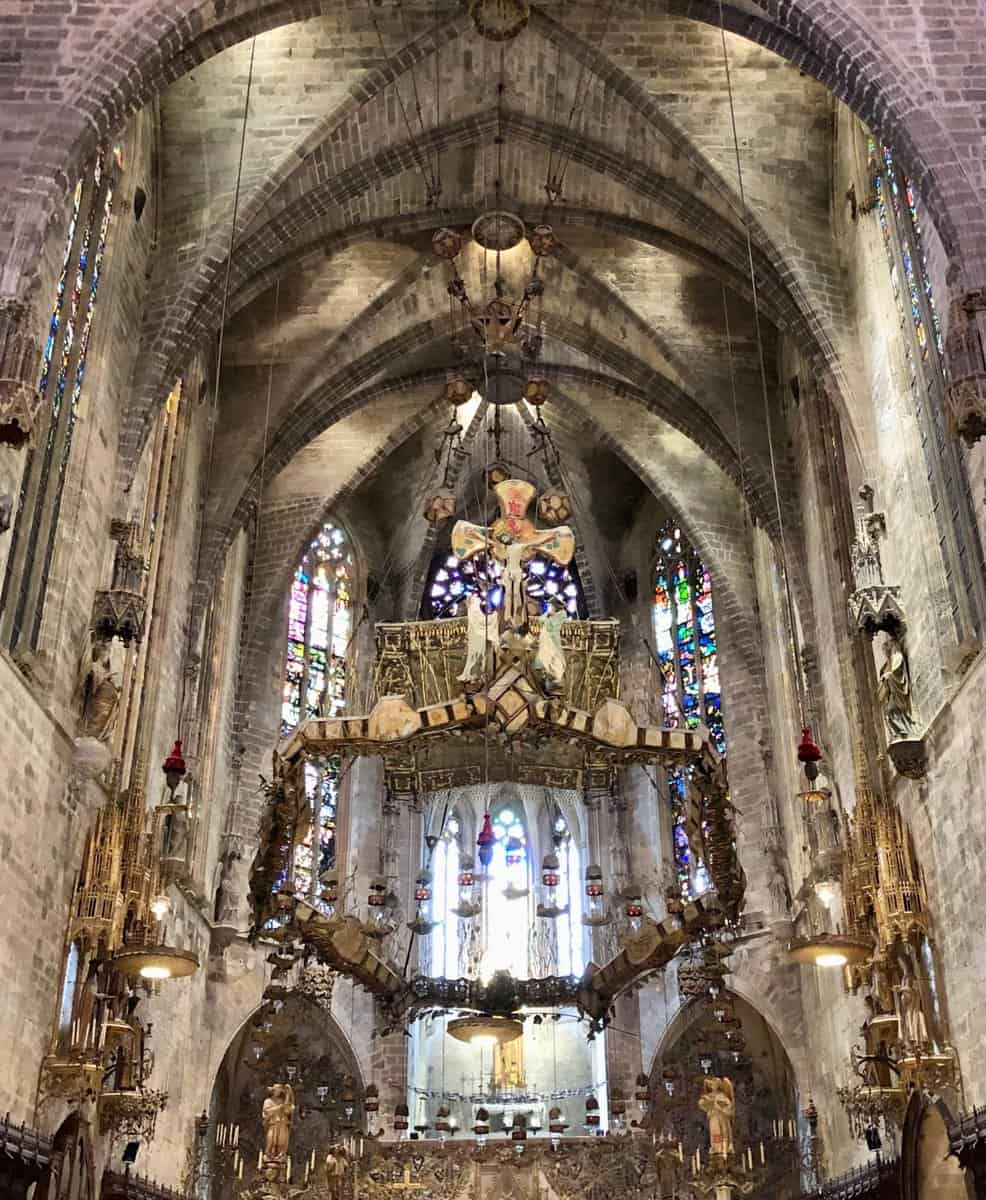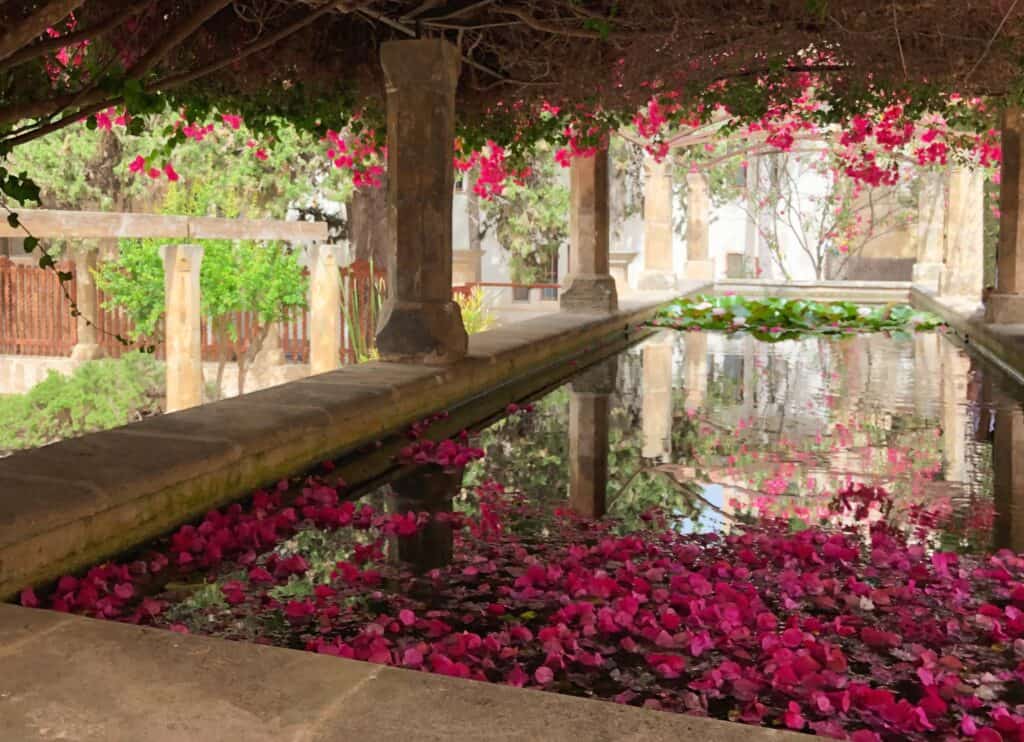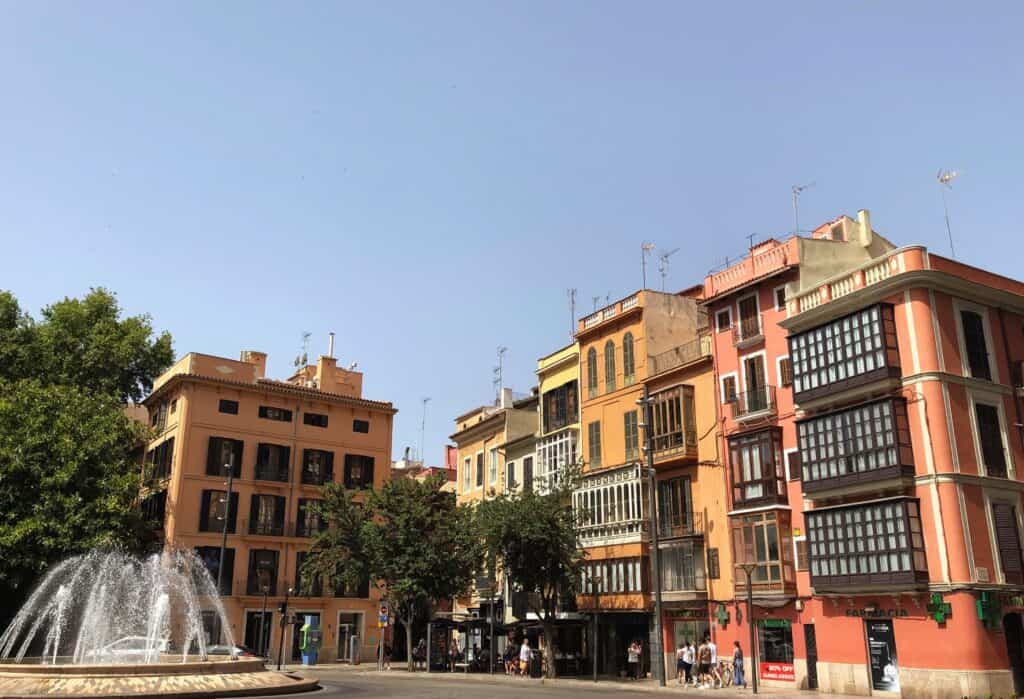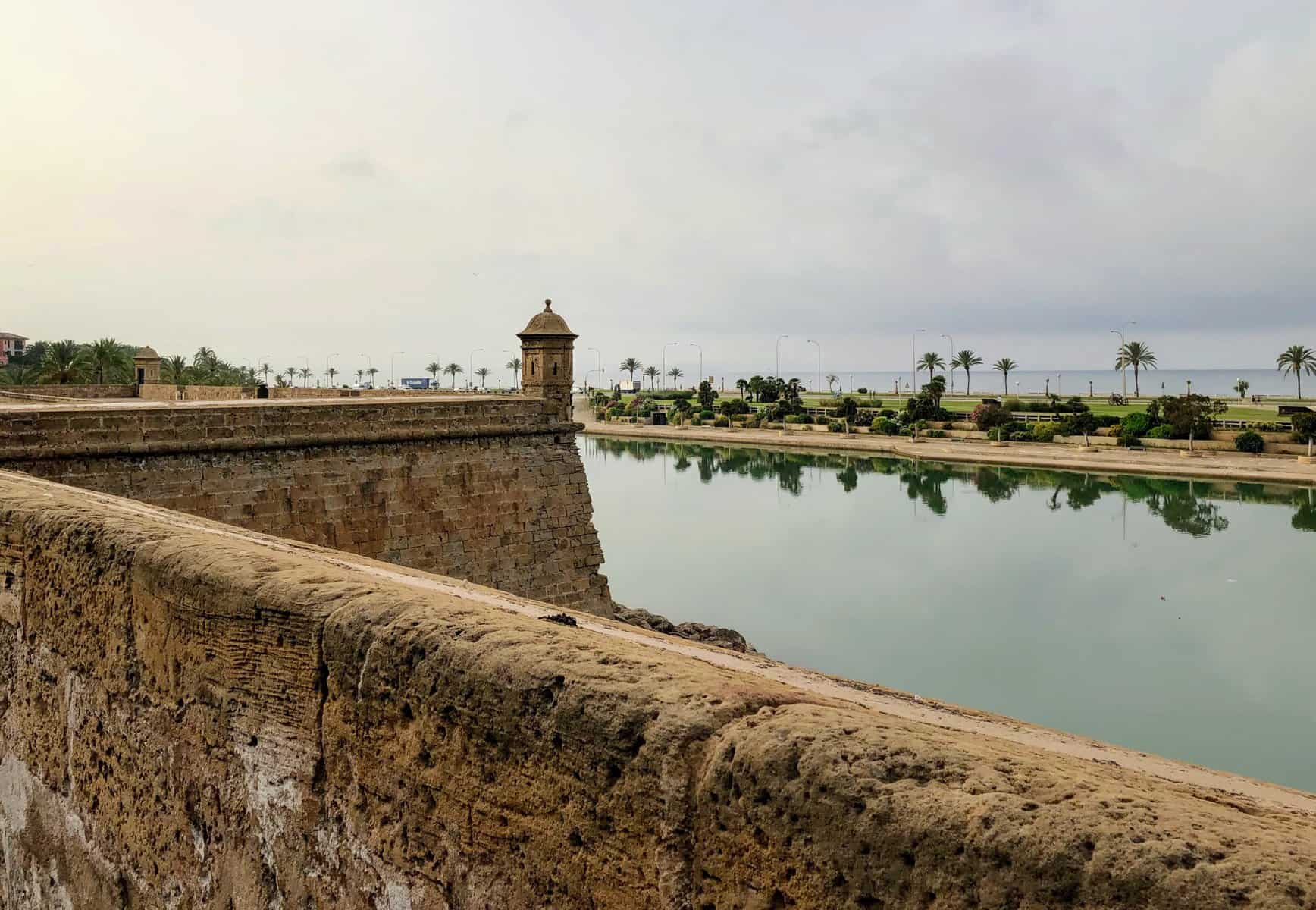A Guide to Palma de Mallorca’s Atmospheric Old Town
From its strikingly modern Gothic cathedral looming over the sea to the stark beauty of its Arab bath complex, Palma de Mallorca’s architecture offers a fresh take on the Middle Ages. As a major center of trade in the Mediterranean, Palma’s shores would have been a familiar sight to people from three continents, and its streets would have echoed with countless languages. Palma’s residents constructed a unique series of buildings which have never gotten the recognition they deserve from historians. Today the city’s medieval streets are a pedestrian’s dream, offering elegant patios and colorful squares alongside landmarks rivalling the best of mainland Spain.
Orientation


Palma’s Old Town encompasses the area within the thousand year-old city walls, which form a rough horseshoe along the shore. Most of the oldest landmarks cluster near the water. Further inland, the warren of tiny medieval streets gives way to boulevards interspersed with larger squares. Our Google map shows the sites mentioned below, all of which lie within walking distance of the sea.
Moorish Palma: Arab Baths
Christian Palma: Royal Palace, Cathedral, Basilica of Sant Francesc, Convent of Santa Clara
Medieval Palma: Jardí del Bisbe, Jewish Quarter, patios
Waterfront Palma: Mercantile Hall, Es Baluard
Promenades and Plaças: Passeig del Born, Plaça de Cort, Plaça del Mercat
Palma’s past
Like many Mediterranean islands, Mallorca picked up culture from a wide range of invaders. A few settlements from the Bronze Age survive on the island, but the city of Palma didn’t exist until Roman times. The Balearic Islands (Mallorca, Menorca, and Ibiza) were named after Quintus Caecilius Metellus Balearicus, who led the Roman occupation in 123 BCE. The earliest record of Christianity dates to 484, but there wasn’t much by way of civilization when the Moors of Córdoba conquered the Balearics in 902. When Moorish Spain fragmented and Christian Europe began to emerge from the Dark Ages, the island’s prime location made it a prized target for various invaders. Christian fleets from Italy to Catalonia fought with Arabic territories for control of Mediterranean trade throughout the 12th century. Eventually King Jaume (James) I of Aragón prevailed, formally annexing Mallorca in 1229.
Moorish Palma
For three centuries, Palma was known as Madina (or Medina) Mayurqa. In spite of political tumult on the mainland, Mallorca prospered under the Moors, while Palma grew large enough to support a mosque with a capacity of 18,000 people. The city’s defensive walls were laid out in this period, as were the labyrinthian streets closer to the water. The latter were oriented to catch local breezes and create shaded areas during the sun’s zenith. Sadly, systematic destruction of Islamic culture by later Christian rule left mere traces of the island’s Moorish history. The Moors remaining on the island were exiled or sold into slavery.
Arab Baths


One of the most tangible glimpses of Moorish Palma can be found in the Arab Baths. Not to be confused with the tiny baths in the Royal Palace, the Banys Àrabs were part of a private residence. Built in the 10th century using ancient columns imported from the Middle East, the baths were important gathering places for the elite. Although the frigidarium (cold pool) had disappeared, the tepidarium (warm room) and the caldarium (steam room) were discovered in the 1960’s.
The caldarium, with its dome pierced by openings to control light and ventilation, packs a lot of drama into a small space, reminding us that Islamic architecture doesn’t require elaborate ornamentation to be powerful.


A sense of peace pervades the garden outside the baths. When the site was restored, the adjacent orchard was converted into an oasis of greenery, evoking the classic Arabic idea of a garden paradise.
Christian Palma
James II merged his territories in southern France, Catalonia, and the Balearic Islands to form the Kingdom of Majorca in 1285. (Technically “Majorca” refers to the kingdom, while “Mallorca” refers to the island.) Although it lasted only until 1343, the kingdom conferred status on Palma and kept it in the forefront of trade in the western Mediterranean. Much of the city’s monumental architecture dates to this period, including the circular Bellver Castle outside the Old Town, as well as the sites listed below.
Royal Palace of L’Almudaina


King James II renovated the existing Moorish fortified palace, modeling it on the French palace in the kingdom’s capital city of Perpignan. The result is a mixture unique to Palma: painted wooden Mudéjar ceilings, wide southern Gothic vaulting, and arcades overlooking palm trees and the sea.

Some of the more notable spaces in the Palau Reial de L’Almundaina include the Salón de Tinell (Great Hall), where the last Moorish ruler Abu Yayah signed the formal surrender. When the Kingdom of Majorca dissolved, the palace was used to house the island’s governors. Today, it’s the official residence of Spain’s royal family when they visit the island.

Cathedral of Palma
Dominating the waterfront, La Seu (literally, “the bishop’s seat”) lives up to its status as the city’s most iconic landmark. The massive Gothic edifice rises straight up from the sea with little ornamentation and strikingly modern lines.


Work on Palma’s cathedral began shortly after King James I’s conquest in 1229. Spanish Christians commonly built cathedrals on the site of a city’s central mosque, and Mallorca was no exception. While the architects were inspired by buildings in France and Spain, the structure took on its own unique form.

La Seu, unlike most Gothic cathedrals, doesn’t rely on massive diagonal supports to hold up the walls. Instead of flying buttresses, it has a row of slender blocks running down each side. Their solidity gives the design exceptional stability, which in turn frees the interior from the need for bulky piers. From the outside, the blocks accentuate the building’s verticality, especially because they were left nearly free of adornment. The cathedral’s more traditional Neo-Gothic façade was added in 1851, after the old one was damaged in an earthquake.
The slenderest of piers separating the three naves plus the extreme height of the walls gives the interior a sense of vastness unusual for the Gothic era. Antoni Gaudí helped streamline the space in the early 1900’s, which further promoted a modern feel. (See our post linked at the end for more information.)

Palma’s cathedral is also called the “Cathedral of Light” thanks to the dramatic effects of its stained glass. Many windows feature kaleidoscopic patterns instead of Biblical images, creating bursts of color which seem to bounce off the walls.
Basilica de Sant Francesc
After the cathedral, the Basilica de Sant Francesc is Palma’s most important – and impressive – church. Founded in 1278, the monastery grew over many centuries as noble families vied to contribute to the influential Franciscan order. The austerity of the façade, reminiscent of the cathedral, contrasts with the Baroque explosion of form over the portal. The interior contains classic Catalan vaulting and, in the cloister, an eclectic series of arcades.


The statue on out front commemorates Junipero Serra, who went to Mexico as a missionary and founded the settlements of Los Angeles and San Francisco. Inside, visitors can pay respect to the tomb of mystic philosopher Ramon Llull, Palma’s most beloved native son.
Convent of Santa Clara


Founded in 1256, the Convent of Santa Clara occupies the site of a former mosque. After multiple expansions and renovations over the centuries, the still-functioning complex remains partially private. The cloistered nuns sell traditional baked sweets to fund their order.
Medieval Palma
Jardí del Bisbe

Tucked away on a tiny side street near the cathedral, the Jardí del Bisbe, or Bishop’s Garden, retains its medieval layout. Ponds with fish and water lilies sit amongst the hedges, vines, and fruit trees of this little haven.
Jewish Quarter
Palma’s former Jewish Quarter, or Call Jueu, is no longer clearly defined. The arch forming its main gate can still be seen at the intersection of the Carrer del Call with the ghetto’s two main streets, the Carrer del Sol and Carrer de Monti-Sion.


Medieval Jewish traders once played a vital role in the economy and were given legal protections. But as persecution of Jews gained strength on the mainland, their position on the island became increasingly tenuous. Hostile Christian sentiment led to the establishment of the Jewish Quarter for both segregation and protection. After wide-scale rioting erupted in 1391, Jews were forced to convert to Christianity or leave the island.
Patios

Palma is famous for the patios in many of its historic buildings. Most include a vaulted or beamed transition area from the street to an arcaded central courtyard and a staircase. Traditional patios include plants, fountains, and furniture; others might hold sculpture galleries or bikes and motorcycles.

We found myriad websites about the patios (ViaGallica.com lists 59), but they are numerous enough and easy to find simply by walking around the Old Town. Some of these buildings have records dating back to before the 1229 Reconquista, and a few even played a role in historic events. The Can Vivot, for example, hosted plotting by Bourbon supporters during the War of Spanish Succession.

The Cambra de Comerç (Chamber of Commerce) has an iron mural depicting Abu Yahya handing the keys of the city to King Jaume I in its patio, as well as the 3rd century BC Roman merchant ship anchor shown above.
Waterfront Palma
The Royal Palace sits in the center of Old Palma’s shoreline. One side is dominated by the cathedral and the Parc de la Mar. On the other side lie two lesser-known but remarkable buildings.
Mercantile Hall

One of the world’s greatest secular Gothic buildings, the Llotja dels Mercaders is a quick, free must-see. Commissioned by Palma’s business community, the hall was built between 1426 and 1447 to serve as a space for the Sea Consuls and general trading. It’s generally considered to be the masterpiece of architect Guillem Sagrera, beating out his work on the Palma and Perpignan cathedrals as well as his renovations of the Castel Nuovo in Naples. Just six slim columns support the roof, spiraling up and branching directly into the vaulting.
Es Baluard

Opened in 2004, this complex incorporates the old city defensive walls into an intriguing series of outdoor spaces over a museum for contemporary art. Modern concrete, metal, and glass merge past and present via interconnecting ramps, terraces, and arches. Along with views of the coastline and cathedral, Es Baluard presents an example of how contemporary architecture can complement the past.

In Moorish times, the surrounding neighborhood included market space and a necropolis. The defensive walls were reinforced in the 16th century and a prestigious artillery school established. Real estate developers tried to obliterate the walls in the 1950’s, sparking a public outcry and the conservation of the site. The diverted river runs from Es Baluard up to the shopping arcades along the Avinguda Jaume III.
promenades and plaças
Plaça de la Reina and Passeig del Born

At the Plaça de la Reina (on the inland end of the palace complex), a pair of stone sphinxes mark the beginning of the Passeig del Born. The river originally ran along this route, but was diverted after too many floods. Afterwards, the open area was used for jousting tournaments; the word born refers to a piece of wood used on spears to safeguard opponents.


Now the Passeig del Born is a popular spot for shopping, strolling, eating, and the occasional concert – like a mellower version of Barcelona’s La Rambla.
Plaça de Cort

The Plaça de Cort takes its name from the feudal courts which used to meet there. Today its highlight is a beloved olive tree, the gargantuan Olivera de Cort, reckoned to be at least 600 years old. In an impressive feat of transplanting, it was moved from northern Mallorca in 1999.
Plaça del Mercat


Out of Palma’s many atmospheric squares, our favorite was probably the Plaça del Mercat. This is where the medieval Church of Sant Nicolau meets early 20th century Modernisme in the twin buildings of the Edifici Casasayas, surrounded by trees, cafés, and colorful shopping streets.
further reading

See our posts on Gaudí and Modernisme in Palma and Art Nouveau Architecture in Sóller.

